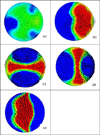Patient-specific bicuspid valve dynamics: overview of methods and challenges
- PMID: 23182904
- PMCID: PMC3552011
- DOI: 10.1016/j.jbiomech.2012.10.038
Patient-specific bicuspid valve dynamics: overview of methods and challenges
Abstract
About 1-2 % of the babies are born with bicuspid aortic valves instead of the normal aortic valve with three leaflets. A significant portion of the patients with the congenital bicuspid valve morphology suffer from aortic valve stenosis and/or ascending aortic dilatation and dissection thus requiring surgical intervention when they are young adults. Patients with bicuspid aortic valves (BAVs) have also been found to develop valvular stenosis earlier than those with the normal aortic valve. This paper overviews current knowledge of BAVs, where several studies have suggested that the mechanical stresses induced on the valve leaflets and the abnormal flow development in the ascending aorta may be an important factor in the diseases of the valve and the aortic root. The long-term goals of the studies being performed in our laboratory are aimed towards potential stratification of bicuspid valve patients who may be at risk for developing these pathologies based on analyzing the hemodynamic environment of these valves using fluid-structure interaction (FSI) modeling. Patient-specific geometry of the normal tri-cuspid and bicuspid valves are reconstructed from real-time 3D ultrasound images and the dynamic analyses performed in order to determine the potential effects of mechanical stresses on the valve leaflet and aortic root pathology. This paper describes the details of the computational tools and discusses challenges with patient-specific modeling.
Copyright © 2012 Elsevier Ltd. All rights reserved.
Conflict of interest statement
We wish to confirm that there are no known conflicts of interest associated with this publication and there has been no significant financial support for this work that could have influenced its outcome.
Figures







Similar articles
-
Patient-specific assessment of hemodynamics by computational fluid dynamics in patients with bicuspid aortopathy.J Thorac Cardiovasc Surg. 2017 Apr;153(4):S52-S62.e3. doi: 10.1016/j.jtcvs.2016.12.033. Epub 2017 Jan 11. J Thorac Cardiovasc Surg. 2017. PMID: 28190607
-
Characteristics of aortic valve dysfunction and ascending aorta dimensions according to bicuspid aortic valve morphology.Eur Radiol. 2015 Jul;25(7):2103-14. doi: 10.1007/s00330-014-3585-z. Epub 2015 Jan 16. Eur Radiol. 2015. PMID: 25591751
-
Late Contained Aortic Root Rupture After Transcatheter Aortic Valve Replacement for Bicuspid Aortic Stenosis.JACC Cardiovasc Interv. 2019 Jul 22;12(14):e121-e122. doi: 10.1016/j.jcin.2019.04.044. Epub 2019 Jun 26. JACC Cardiovasc Interv. 2019. PMID: 31255557 No abstract available.
-
Transcatheter aortic valve replacement in bicuspid aortic valve stenosis: where do we stand?J Cardiovasc Surg (Torino). 2018 Jun;59(3):381-391. doi: 10.23736/S0021-9509.18.10350-8. Epub 2018 Jan 11. J Cardiovasc Surg (Torino). 2018. PMID: 29332374 Review.
-
Bicuspid aortic valve and associated aortopathy: an update.Semin Thorac Cardiovasc Surg. 2013 Winter;25(4):310-6. doi: 10.1053/j.semtcvs.2014.01.004. Epub 2014 Jan 24. Semin Thorac Cardiovasc Surg. 2013. PMID: 24673960 Review.
Cited by
-
Fully coupled fluid-structure interaction model of congenital bicuspid aortic valves: effect of asymmetry on hemodynamics.Med Biol Eng Comput. 2013 Aug;51(8):839-48. doi: 10.1007/s11517-013-1055-4. Epub 2013 Mar 10. Med Biol Eng Comput. 2013. PMID: 23475570
-
Changes in aorta hemodynamics in Left-Right Type 1 bicuspid aortic valve patients after replacement with bioprosthetic valves: An in-silico study.PLoS One. 2024 Apr 16;19(4):e0301350. doi: 10.1371/journal.pone.0301350. eCollection 2024. PLoS One. 2024. PMID: 38626136 Free PMC article.
-
Computational mitral valve evaluation and potential clinical applications.Ann Biomed Eng. 2015 Jun;43(6):1348-62. doi: 10.1007/s10439-014-1094-5. Epub 2014 Aug 19. Ann Biomed Eng. 2015. PMID: 25134487 Free PMC article. Review.
-
4D subject-specific inverse modeling of the chick embryonic heart outflow tract hemodynamics.Biomech Model Mechanobiol. 2016 Jun;15(3):723-43. doi: 10.1007/s10237-015-0720-y. Epub 2015 Sep 11. Biomech Model Mechanobiol. 2016. PMID: 26361767 Free PMC article.
-
Fluid dynamics of coarctation of the aorta and effect of bicuspid aortic valve.PLoS One. 2013 Aug 27;8(8):e72394. doi: 10.1371/journal.pone.0072394. eCollection 2013. PLoS One. 2013. PMID: 24015239 Free PMC article.
References
-
- Antiga L, Piccinelli M, et al. An image-based modeling framework for patient-specific computational hemodynamics. Med Biol Eng Comput. 2008;46(11):1097–1112. - PubMed
-
- Burken JA. Biomedical Engineering. The University of Iowa; 2012. Determining the Effect of Congenital Bicuspid Aortic Valves on Aortic Dissection Using Computational Fluid Dynamics. M.S.
-
- Cecconi M, Manfrin M, et al. Aortic dimensions in patients with bicuspid aortic valve without significant valve dysfunction. Am J Cardiol. 2005;95(2):292–294. - PubMed
-
- Christie GW, Barratt Boyes BG. On stress reduction in bioprosthetic heart valve leaflets by the use of a flexible stent. J Card Surg. 1991;6(4):476–481. - PubMed
-
- Conti CA, Della Corte A, et al. Biomechanical implications of the congenital bicuspid aortic valve: a finite element study of aortic root function from in vivo data. J Thorac Cardiovasc Surg. 2010;140(4):890–896. 896, e891–e892. - PubMed
Publication types
MeSH terms
Grants and funding
LinkOut - more resources
Full Text Sources
Other Literature Sources
Medical

